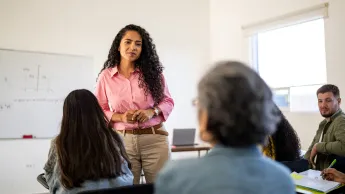What contribution can DAAD alumnae and alumni make to the internationalisation of higher education institutions? And can the sustainable development goals be integrated into teaching? Clarissa Núñez Amador from Honduras explains in an interview the related results delivered by a workshop she co-organised – and why it depends on each and every individual.
Ms Núñez Amador, you recently co-organised a workshop series that dealt with the internationalisation of higher education –to which former DAAD beneficiaries could make a contribution. What were the key results?
It involved improving the internationalisation skills of alumnae and alumni who teach at higher education institutions in Latin America. Those who participated formed networks with participants from other Latin American countries and disciplines, and combined into groups in which they would like to collaborate on one of eight curriculum projects dealing with internationalisation. These projects adopt an interdisciplinary approach to integration of the . This involves them using the so-called COIL (Collaborative Online International Learning) methods – in which the participants collaborate beyond borders in mixed teams.
Why are innovative approaches to the internationalisation of higher education so important?
It’s an assumption nowadays that lecturers can use digital methods to provide international education. Networking has thus become a form of teaching practice that not only includes lecturers and students from a single local study programme, but also for instance teaching staff from abroad and from other faculties. This means that the teaching staff can become part of a regional or international community that supports them in overcoming this challenge.
We have found that the lecturers adopt innovative methods based on individual approaches. This involves them using their own resources and their international background. It’s important to discern the lecturers’ individual practices and determine whether these are associated with previous international experience. Measuring the impact of alumnae and alumni who have become lecturers at higher education institutions, and the emergent improvement in their teaching, can provide us with new stimulation. The interdisciplinary approach is innovative; it is useful in international collaboration.
What part does the COIL method play with respect to collaborative international learning?
COIL is a method that, in addition to other virtual means, became very popular during the coronavirus pandemic. This method’s strength is that contains clear instructions for the lecturers, which facilitate virtual international collaboration among lecturers from different countries. There is explicit regulation of the procedure, methods, assignments, and even the schedule and group formation. COIL to a certain extent replaces personal mobility within teaching. It is a beneficial tool for lecturers who are prepared to collaborate with international colleagues.
We have however noticed that it’s a challenge for lecturers without international experience to find international colleagues who are prepared to implement a COIL project. This means that networking in an international context is required to advance COIL within teaching. It serves no purpose if lecturers know the COIL method, but don’t have any colleagues with whom they can network or establish and maintain a community.
This workshop series also dealt with how the sustainable development goals (SDGs) can be integrated into curricula...
The good news is that there are low-threshold projects which lecturers can incorporate into the curricula for their courses. These can with little effort be included as stand-alone projects or be implemented in collaboration with other national or international colleagues. These practices can contribute to discernment of what lecturers are already doing to realise the SDGs within higher education. I believe that some lecturers are already informally improving the integration of SDGs into their curricula, although this collaboration is not being made visible or recognised.
Lecturers should for instance analyse the learning outcomes from their courses and the associated correlation with the SDGs. They should know the SDGs to which they are contributing, or would like to contribute depending on their field of expertise. They can then add further research methods to their courses by means of which the students can conduct research.
What did you achieve in this regard within the workshop series?
There were in total 70 lecturers from Latin America who registered and took part in four sessions of activities from May to October 2024. The events included a panel discussion concerning best practice in the internationalisation of curricula in Latin America, a conference that included the expert in internationalisation of curricula, Dr Pablo Beneitone from the National University of Lanús in Argentina, three sessions on COIL methodology and a session on awareness of the SDGs. These international cooperation projects adopt a broadly based approach as part of interdisciplinary collaboration. Everything was prepared together with COIL simulation expert Dr Yamila Silva, who acted as moderator and coach for the projects, and who has previous experience working with higher education institutions in Latin America.
To what extent does international collaboration promote the sustainable development goals?
The conversation regarding best practice involving like-minded people from different disciplines and in an international context offered an innovative approach to integration of the SDGs. The participants use their courses to promote topics relating to sustainability, such as climate change, health and the environment. But they also learned that it’s possible to integrate the SDGs into courses where an interdisciplinary approach wasn’t obvious to them, including water, gender and community, artificial intelligence, sustainable logistics and marketing. The activities within an international cooperation project offered the alumnae and alumni an open space in which they could express and realise their ideas and aspirations. There may be various reasons why this freedom isn’t available to them within their institutions. The international community created a kind of ‘safe space’ for them; an atmosphere of trust and some leeway for them to consider how to advance the integration of SDGs within their courses.

